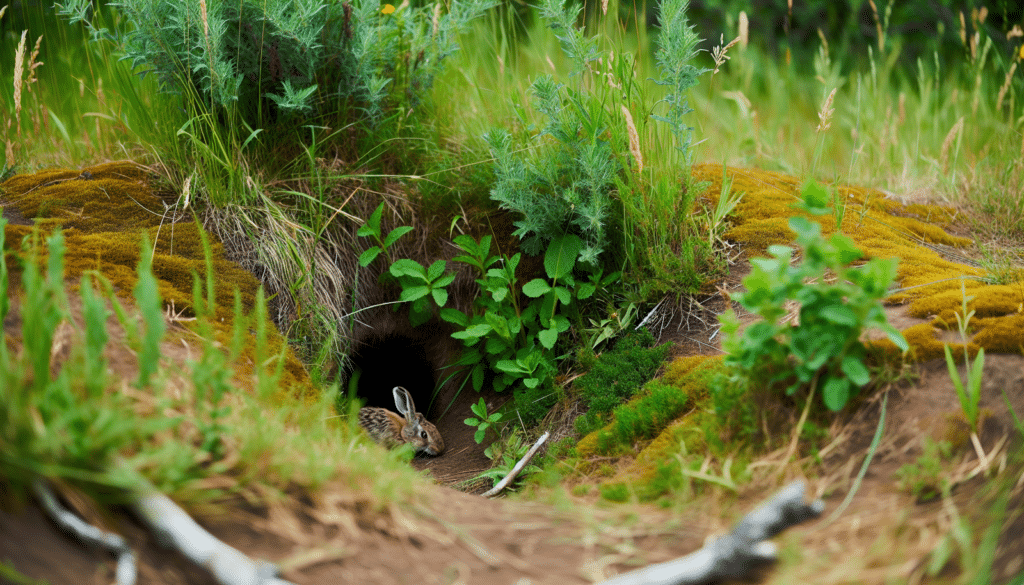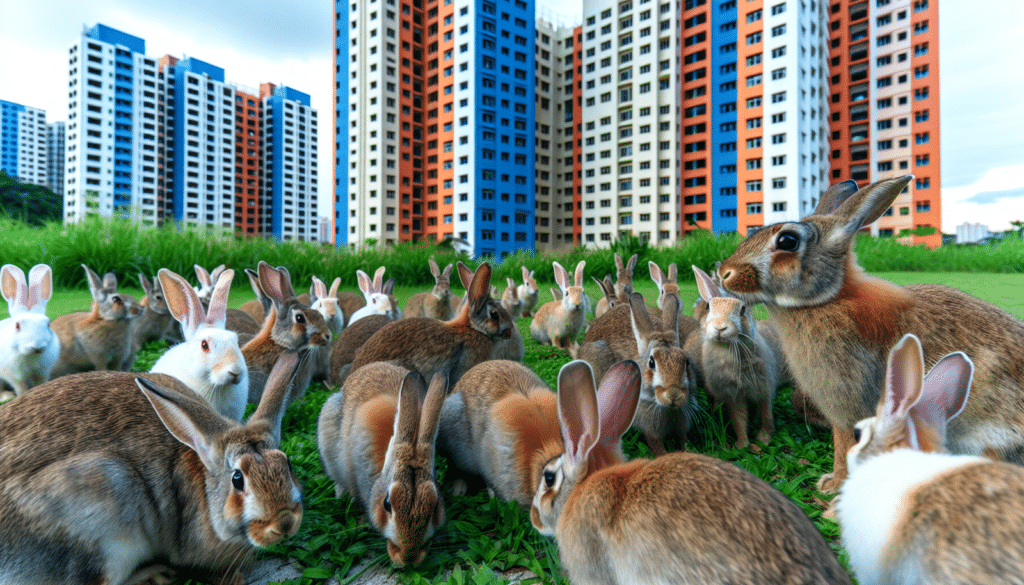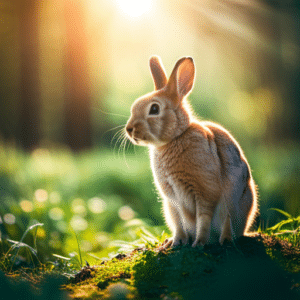How do rabbits survive and thrive in the wild? This article explores the critical behaviors that define wild rabbit life, from the formation of social hierarchies to the nuanced ways they communicate and defend their territories. Understand the reality behind these seemingly delicate creatures’ strong survival instincts, as we shed light on the factors that drive their daily lives. Discover the essence of rabbit behavior in the wild, through insights that showcase their remarkable adaptability and resilience.
Key Takeaways
Wild rabbits are highly social animals, forming sophisticated social structures within their colonies, using intricate communication methods, and displaying complex territorial behaviors to maintain social order and resource availability.
As herbivores, wild rabbits engage in selective foraging to optimize nutrient intake from their primarily vegetarian diet, adjusting their foraging behaviors to seasonal changes to maintain consistent nourishment.
Wild rabbit populations are impacted by human activities, such as urbanization and habitat loss, necessitating behavioral adaptations to survive in changing landscapes and fragmented habitats.
Wild Rabbit Social Dynamics

Wild rabbits are not the solitary creatures we often imagine them to be. On the contrary, they reside in extensive colonies, forming social groups consisting of up to three males and five females, including adult rabbits. Their social conduct is centered on cooperation, communication, and the preservation of a tightly-knit family unit, which includes baby rabbits. This cohesive social behavior is reminiscent of our human societies, isn’t it? Interestingly, domesticated rabbits, like their domestic rabbit counterparts, can also exhibit similar social traits, which is why organizations like the House Rabbit Society exist to promote their well-being.
These social groups are not random aggregations of individuals but rather intricately structured communities. Like a well-ordered society, they establish a hierarchical social structure characterized by linearity. The formation of these groups is not just a social endeavor but a survival strategy that helps protect their habitat and ensure the survival of young rabbits.
Group Formations
Intrigued by how these endearing animals organize their societies? Wild rabbits, such as the cottontail rabbit, create their social groups by aligning themselves with individuals of the same sex. This behavior is not arbitrary but rather a strategic move for survival. Group formation promotes social interaction, companionship, and the creation of a hierarchical structure within their warren, thus safeguarding their habitat and species.
Now, if you think these groups are free-for-alls, think again. Within their group formations, a hierarchical social structure emerges. A dominant pair or family usually secures the top spot, while others assume subordinate roles. These breeding colonies also exhibit a hierarchical structure with rank orders segregated by sex, which is not unlike many human societies!
Communication Methods
Just like in any society, communication is vital in rabbit communities. Wild rabbits employ both body language and vocalizations to interact within their social groups. Not confined to social interactions, these communication methods are integral to their survival.
Wild rabbits wield scent as a powerful tool for communication. They employ pheromones to convey information regarding identity, territory, sex, and more. This is especially important for territorial scent marking, which signals ownership to other rabbits. Moreover, their vocalizations range from soft squeals or whimpers to grunts, snorts, and hisses. These sounds serve as a communication channel within their close-knit communities, particularly around a rabbit nest, where they communicate with each other and protect their young. Isn’t it fascinating how wild rabbits have developed such complex communication methods?
Territoriality
Anyone who has ever had a pet rabbit knows they can be quite territorial, and wild rabbits are no different. They mark their territories using their chins and their sense of smell. Territoriality is a survival mechanism, essential in safeguarding their habitat and offspring. Wild rabbits take their territory seriously!
The territorial range of a wild rabbit averages around 6 to 8 acres for males and 2 to 4 hectares for females, though this can vary based on their environment and social status. When their territory is invaded, they exhibit aggression towards the intruder, perceiving them as a potential threat. This territoriality contributes significantly to the maintenance of social order and the availability of resources within their habitat. It’s quite a sophisticated system, don’t you agree?
Wild Rabbit Feeding Habits

Setting aside territorial issues, let’s examine the feeding habits of wild rabbits. Wild rabbits are primarily herbivores, consuming a variety of vegetation including clover, dandelions, grasses, and flower and vegetable plants. They exhibit foraging behavior by selectively grazing on various plants available in their habitat. While they do adjust their feeding times based on the presence of plant material, they generally engage in feeding throughout the day.
On an average day, wild rabbits consume approximately 2 pounds of grass and other plant materials.
Foraging Techniques
Wild rabbits excel in the art of foraging. They use techniques such as:
Grazing grass from the ground
Browsing leaves from trees
Consuming leafy plants
Stripping bark
Excavating roots to chew
They are not just indiscriminate eaters though. Their foraging behavior reflects a strategy known as selective grazing, which enables them to target specific plant species, thereby optimizing their nutrient intake.
Additionally, wild rabbits practice rapid feeding. This allows them to efficiently fulfill their nutritional requirements from their generally low-nutrient diet, while also helping to prevent behaviors associated with boredom. Seasonal changes also play a role in their foraging behavior. Wild rabbits adjust their foraging strategies in accordance with these changes, utilizing various habitats to maintain a consistent nutrient intake throughout the year.
Food Preferences
Wondering what’s on a wild rabbit’s menu? They have a preference for certain grasses such as timothy, orchard grass, meadow fescue, and Kentucky bluegrass, along with leafy weeds like clover and dandelions. They also have a fondness for vegetable scraps such as the leafy parts of carrots, strawberries, broccoli, celery, Brussels sprouts, and cauliflower.
During the evening hours and throughout the night, particularly during cold weather or when food resources are scarce, wild rabbits may consume bark and twigs. Their diet changes somewhat with the seasons. While they maintain a diet of grasses, weeds, and herbs throughout the year, during autumn and winter, they broaden their diet to include the bark of shrubs and plants such as blackberry bushes, cherry trees, and winter wheat.
Wild Rabbit Survival Strategies
Surviving in the wild demands skills, and wild rabbits, as a type of wild animal, have evolved an array of strategies to flourish in their natural surroundings. One of their key survival strategies is predator evasion. They employ their remarkable speed, agility, and camouflage to swiftly dart into burrows or move in a zigzag pattern at high velocities to elude predators.
Wild rabbits also employ strategic behaviors such as:
sprinting
avoiding open spaces
performing sharp turns
squeezing into small spaces
quickly running away
These behaviors help them evade predators and ensure their survival.
Let’s further investigate these evasion strategies and their burrow systems.
Predator Evasion

When it comes to predator evasion, wild rabbits have developed quite an arsenal of tactics. They:
Freeze in their tracks
Blend in with their surroundings
Stay motionless to avoid detection by predators
Employ zigzag running, which makes it difficult for predators to anticipate their movements and successfully capture them.
Another critical component of their evasion strategy is their burrow system. Wild rabbits use their burrow systems for protection, providing a secure location to rest, rear their offspring, and promptly find shelter from predators during hazardous situations. It’s quite impressive how these cute creatures have developed such sophisticated survival strategies, isn’t it?
Burrow Systems

Burrow systems are more than just a place to hide for wild rabbits. They are sophisticated subterranean constructions that serve as:
a refuge
a nesting location
a food storage
a breeding area
a waste disposal site
Wild rabbits utilize their robust nails and proficient front paws to excavate and scratch away at the ground to construct their burrows. These burrow systems generally comprise various chambers, such as sleeping chambers, nesting chambers, and occasionally toilet chambers. These burrows do not just provide safety but are an integral part of their survival strategies.
Wild Rabbit Reproductive Behaviors
Reproduction is fundamental for any species, wild rabbits included. They typically commence breeding as early as 2 to 3 months old, with the gestation period typically lasting 29 to 33 days. Unlike some animal species, wild rabbits are polygamous and do not engage in lifelong mating. They often select the closest rabbit for mating and may occasionally mate with the same partner.
Mother rabbits play a crucial role in the survival of their offspring, especially when it comes to their rabbit nests. They provide brief nursing sessions for their babies, lasting approximately 5 minutes each day.
Let’s delve deeper into these reproductive behaviors.
Mating Rituals
The world of wild rabbit mating rituals is full of chasing, leaping, and displays of agility and strength. Prior to mating, wild rabbits engage in ceremonialtic dance, where the male pursues the female until she comes to a halt and directly faces him, leading to a display of boxing with her front paws.
These behaviors are not merely a spectacle but play a crucial role in attracting and selecting a suitable mate. Agility and strength are demonstrated by energetically leaping, twisting, turning, and overcoming obstacles, which also helps in evading predators and, in turn, attracting potential mates.
Gestation Period
The gestation period for wild rabbits is relatively short, typically lasting 29 to 33 days. This allows for the possibility of numerous litters in a year, with each litter usually consisting of between one and 12 babies.
The average litter size of a wild rabbit is five or six.
Parental Care
Rabbit mothers provide sole care for their young, nursing them briefly once or twice a day with highly nutritious milk. They typically feed their young, including the baby rabbit, once or twice a day, usually during the night. Once their eyes open, baby rabbits can be slowly introduced to solid foods such as alfalfa pellets and hay, and after 6 weeks, vegetables and fruits are incorporated into their diet.
By around three weeks of age, young wild rabbits, like any young rabbit, achieve independence from their mothers. It’s quite a short period of parental care compared to many other animals, isn’t it?
The Impact of Human Activity on Wild Rabbit Behavior
As human activity continuously changes natural landscapes, wildlife, including wild rabbits, must adapt to endure. Habitat loss has resulted in a decline in wild rabbit populations and a disruption of their behaviors. However, wild rabbits have shown remarkable adaptability to environmental changes caused by human activity.
Wild rabbits have adeptly adapted to diverse urban settings, including cities and regions such as the Puget Sound Region. However, land development can result in habitat loss and fragmentation, which can have adverse effects on the natural behaviors and population dynamics of wild rabbits.
Urbanization

The expansion of cities and towns, habitat reduction due to the construction of new roads and dams, and growth of brush and agricultural fields have all contributed to a rise in wild rabbit populations in urban areas. In these urban environments, they alter their behavior and survival strategies to mitigate risks, acclimating to fragmented landscapes and finding alternative food sources.
In urban and suburban environments, wild rabbits typically:
Feed on grasses, forbs, garden plants, and woody vegetation
Find refuge under trees and in locations with unmowed grass
Must remain cautious of predators like cats and dogs, as well as competing animals such as rats.
Habitat Loss
Factors contributing to habitat loss for wild rabbits include habitat specialization, lack of food or shelter, and the demise of particular habitats like old fields, shrublands, and young forests. This loss of habitat has led to a noticeable reduction in the historical range of wild rabbit populations.
In response to habitat loss, wild rabbits display alterations in behavior, such as relocating to non-native habitats and adjusting their response to the presence of predators or competitors. While some species of wild rabbits have managed to adapt to habitat loss, others have been pushed to the verge of extinction.
Summary
We’ve hopped through the world of wild rabbits, exploring their social dynamics, feeding habits, survival strategies, and unique reproductive behaviors. We’ve also discussed how human activity impacts their behavior and survival. From their complex social structures to their impressive survival tactics, wild rabbits are a marvel of nature’s adaptability. Let’s strive to coexist with these fascinating creatures and ensure their survival in the changing landscapes of our planet.
Frequently Asked Questions
How do rabbits behave in the wild?
In the wild, rabbits are solitary and most active between dusk and dawn. They communicate using soft grunts, purrs, and by thumping the ground with their hind feet. When caught by a predator, they can produce a bloodcurdling scream.
What are the natural behaviors of rabbits?
Rabbits have natural behaviors such as digging, running, jumping, rearing up, hiding, eating, and socializing with other rabbits. It’s important to provide them with plenty of opportunities to carry out these behaviors.
What are the typical components of a wild rabbit’s diet?
A wild rabbit’s diet typically consists of vegetation such as clover, dandelions, grasses, wildflowers, shoots, and leaves from various plants and grasses. It’s important to note that this diet is primarily based on their natural habitat, and may vary slightly depending on the specific region.
What specific adaptations enable wild rabbits to thrive in their natural environment?
Wild rabbits thrive in their natural environment due to adaptations like camouflage fur, heightened senses, rapid locomotion, and flexible necks to enhance their visibility. These adaptations help them survive and thrive in the wild.
What are the behaviors displayed by wild rabbits during their mating rituals?
Wild rabbits display a ceremonial dance, where the male pursues the female until she stops and faces him, leading to a boxing display with their front paws. This behavior is part of their mating ritual.



